Riverbed 830-01 RCPE Certified Professional WAN Optimization Exam Practice Test
RCPE Certified Professional WAN Optimization Questions and Answers
What is the purpose of ‘Peer Affinity’ on the Interceptor?
You have a SteelCentral Controller for SteelHead Mobile with a policy that includes auto-discovery rules, enabled Location Awareness and set a minimum latency of 10ms. Your client is now in the branch office, has received this policy and the nearest SteelHead is 2 ms away. What will happen to connections?
Once a SteelHead is registered for Cloud (SaaS) optimization it contacts the Cloud portal every 5 minutes to receive the latest information about the service. What would happen if a Firewall change stops the HTTPS communication with the Portal?
Citrix optimization does not work although you removed ports 1494 and 2598 from the Interactive Ports label and enabled Citrix optimization on the client-side Steelhead appliance. What could be the problem? (Select 2)
A customer would like to optimize an in-house application running over UDP. What is required in order to do this? (Choose two.)
-- Exhibit –
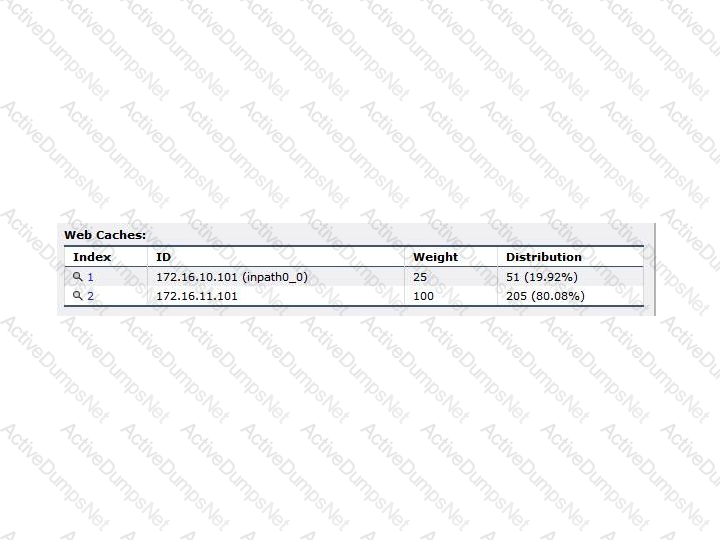
-- Exhibit --
Refer to the exhibit. In a WCCP environment with R3, SH10 and SH11, the following screenshot shows that the load is not being distributed evenly in between the Steelhead appliances. Why?
A SteelHead blocks all traffic when the appliance is powered off. What reasons could cause this behavior? (Choose two.)
True or False? To be able to use Active Directory assignments, the SteelCentral Controller for SteelHead Mobile must be joined to the domain.
-- Exhibit –
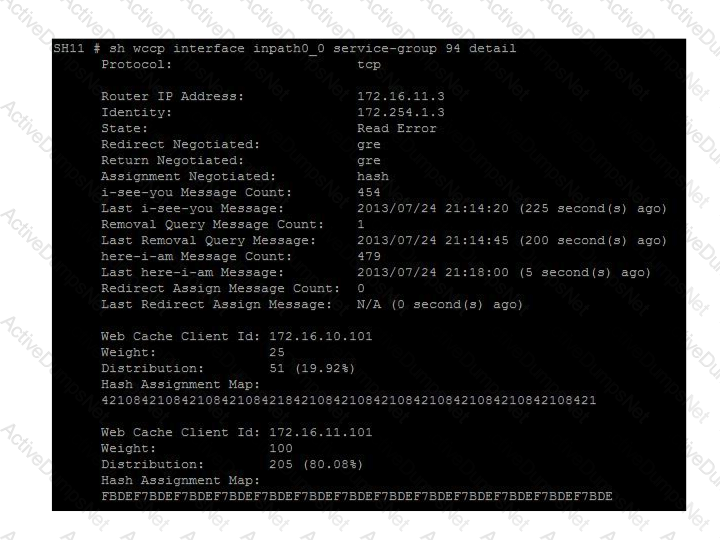
-- Exhibit --
In a WCCP environment with R3, SH10 and SH11, it was observed that SH11's WCCP state is "read error". What is the possible cause?
What type of problem does the error message below indicate:
Sep 13 03:50:51 SH alarmd[18371]: [alarmd.NOTICE]: Alarm 'admission_mem' triggering
Sep 13 03:50:51 SH alarmd[18371]: [alarmd.NOTICE]: Alarm 'admission_control' triggering
Sep 13 03:50:51 SH alarmd[18371]: [alarmd.NOTICE]: Alarm 'health' severity changed to 'Admission Control'
Examine the diagram below. The customer needs to optimize data center servers and also servers within the DMZ but wants to keep the SteelHead behind the firewall. Which optimization mode would support this environment?

Branch office users live streaming video URL fragment requests are not optimized even though Microsoft Silverlight stream splitting is enabled. What could be the causing this? (Select 3)
You deploy a pair of SteelHead appliances in-path. At the server-side, there is a firewall inspecting traffic between the SteelHeads. The firewall must see the original client and server IPs and is configured to drop packets where the same host pairs and port pairs are reused within 30 seconds of termination. Which addressing mode would workaround this issue?
A branch has a Virtual SteelHead VCX75-5H. Recently, staffing levels have changed and the best model for the branch is now a VCX555-L. What is required to downgrade the model?
You plan to downgrade a SteelHead from RiOS v9.0.1 (Apr 17 2015) to 8.6.3 (Aug 7 2015). The appliance was previously running v8.6.3 but was factory reset after the upgrade. Will this be successful?
Refer to the exhibit.
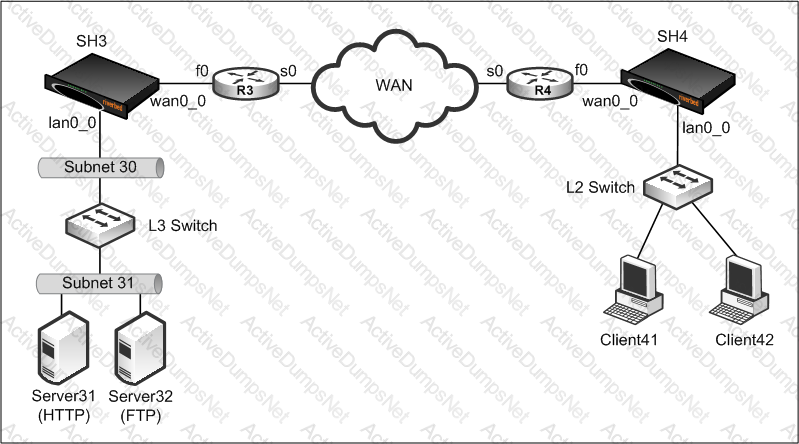
A connection times out when Client41 and Client42 attempt to either establish an HTTP session to Server31 or an FTP connection to Server32 after not connecting to them for some time. The very next attempt to connect to these services done immediately after the failure seems to work correctly. The clients are able to ping both servers and no access-lists are configured on the routers. SH3 uses the IP address of R3f0 as its default gateway. Upon powering off SH3 and SH4, the problem goes away even for first connection and everything works normally (even after not connecting for extended periods of time). Which of the following are likely to correct this problem?
What command should you use to see the direct URL of a package?
The Optimization service has been disabled on a Steelhead appliance. Which of the following events occur as a result?
The Home page in the Management Console for the CMC appliance can be configured to display what information?
What can be monitored via the CMC appliance? (Select 2)
You need to take a full packet trace from the WAN interface of a Steelhead appliance to send into technical support. Which of the following commands will achieve this assuming typical Ethernet MTU? (Select 2)
With these default registry parameters, SMB signing is negotiated in the following manner. (Select 2)
You have an in-house HTTP application running on port 8443 but you are not seeing HTTP optimization. You checked and made sure that the HTTP blade is enabled. What is the likely problem?
Given four Steelheads are deployed in a WCCP cluster and all Steelheads are optimizing traffic to and from the data center. Steelhead-A fails and only Steelhead-B and Steelhead-C are intercepting new connections while Steelhead-D is NOT optimizing any traffic. What is the likely problem?
What methods can the CMC appliance use to provide notification of CMC system events? (Select 3)
The default setting for “allow failure” in the Interceptor appliance version 2.0 is: (Select 2)
How many in-path rules will a WAN-initiated (i.e. SYN packet arrives at a WAN port of an In-path interface) single connection match? Assume no packet ricochet occurs (i.e. the SYN travels through the Interceptor appliance once).
You are troubleshooting a new Steelhead Mobile installation where none of the VPN users with Steelhead Mobile client installed are being optimized. You determine that the Steelhead appliance in the data center is not in-path for VPN users. What are your options to fix this? (Select 2)
The port used by the Steelhead appliance for datastore synchronizations is:
Which two of the following attributes are required to be added to a TACACS+ server to enable monitor and admin logon access to the CMC appliance via TACACS: (Select 2)
On an Interceptor appliance running Fair Peering v2, what Steelhead characteristic is used to calculate peer affinity?
How do you clear the peer affinity information from an Interceptor?
What is the default trap severity for system messages?
When deploying failover Interceptors, all in-path interfaces must:
Hybrid Mode can best be defined as a combination of:
SH10 and SH11 are connection forwarding neighbors. After a configuration change on SH11, SH10 is in "degraded" status. What is the possible cause? (Select 2)
What is the process for dropping the connection of an individual user that is currently being optimized? As an example, consider an HTTP connection being optimized with a local address of 192.168.5.10 and remote address of 192.168.5.90. (Select 2)
Which of the following points on WCCP v2 are correct? (Select 4)
A single client-server TCP connection is made through two Steelhead appliances (default in-path deployment). This is a lab-controlled environment and no other client-server connections are made. How many TCP connections will exist between the in-path interfaces of both Steelhead appliances after the user connection is fully established?
What is the command to view configuration files on the CLI?
Which of the following statements are true about server-side out-of-path deployments? (Select 4)
What is the command to return a Steelhead appliance back to factory defaults?
You choose to deploy a Steelhead appliance logically in-path using policy-based routing (PBR) as the traffic redirection method. Additionally, you want to mark the Type of Service (ToS) value for active FTP as AF21 using route-maps. Which route-map specified Type of Service (ToS) value is correct? (Hint: Use the calculator)
A server-side logical in-path deployment is shown in the exhibit. Additionally, SH12 is configured with a fixed-target rule pointing to SH11. The client behind SH12 will not be able to establish a connection to SERVER1 as a logical loop will occur when the number of optimized connections in SH11 has reached the maximum system limit.
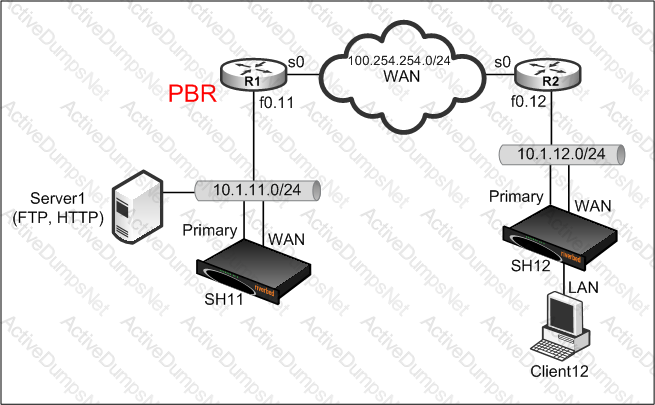
What is the best way to resolve this issue?
Which of the following interfaces should be used for datastore synchronization? (Select 2)
A customer would like to deploy the Interceptor appliance on four aggregated 100 Mbps links which use LACP to bundle the physical links into a single logical link. Which of the following is true? (Select 2)
Three Steelhead appliances SH1, SH2, and SH3 are deployed as shown in the exhibit. They are all using the default auto-discovery rule for optimization. However, CLIENT99 experiences a failure when attempting to access either the HTTP or FTP service on SERVER88. CLIENT99 was able to access these services prior to the deployment of the three Steelhead appliances.

Which of the following choices would most likely correct the problem?
Why should you use promiscuous mode on each in-path virtual NIC for Virtual Steelhead appliance? (Select 2)
In a quad Interceptor appliance deployment the directly connected pairs are configured in failover mode:
IC-A & IC-B are failover buddies
IC-C & IC-D are failover buddies
To prevent asymmetric routing IC-A should be configured to have a neighbor relationship with which of the following peer Interceptors? (Select 2)
In a WCCP cluster using mask assignments, if there are six Steelhead appliances in the cluster, what is the minimum number of bits that should be used?
For In-path rules on an Interceptor appliance, Source and Destination subnets are specified in what format? (where “x” is any single digit number):
Refer to the exhibit.
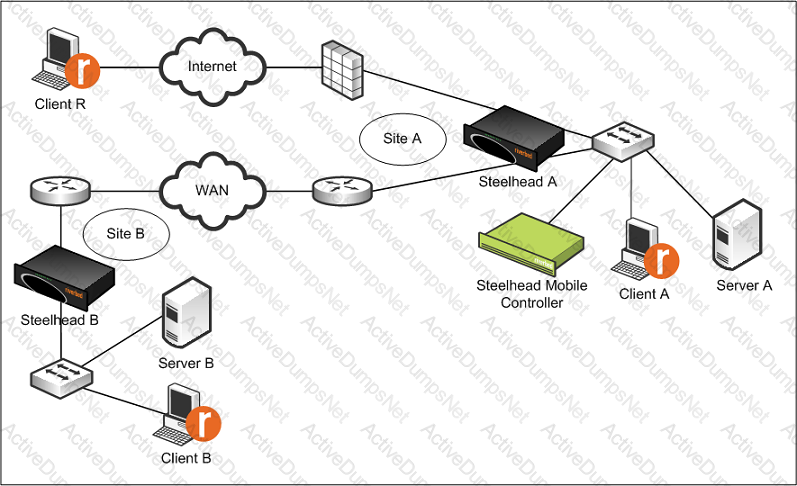
What option in the Acceleration policy used on Steelhead Mobile Client A will most likely enhance the users experience connecting to Server B, if Server B is an Exchange 2003 Server?
Which of the following are Steelhead Mobile Controller alarms? (Select 2)
What platform is supported by SMC-VE?
What is configured in an Endpoint policy? (Choose the best answer)
Which authentication methods are available to the Steelhead Mobile Controller?
What are the possible ways to downgrade a Virtual Steelhead appliance after it has been upgraded?
What are the SSL trusts that must be configured for a Steelhead Mobile client to successfully optimize SSL traffic? (Select 2)
You would like your Steelhead Mobile clients to automatically detect when they are in a branch office with a local Steelhead. You have decided that the Steelhead Mobile Client should only optimize connections if the Steelhead appliance is more than 10 ms away. What is the name of the feature you need to enable?
To verify that the Steelhead Mobile client software is running, what process should you look for in the Windows Task Manager?
